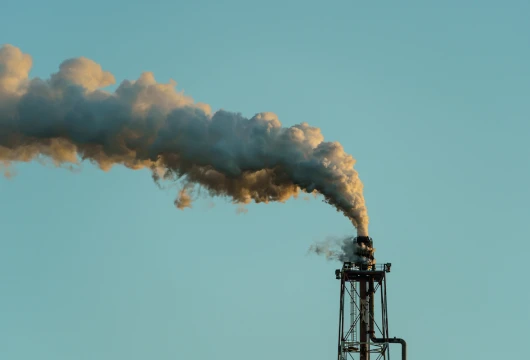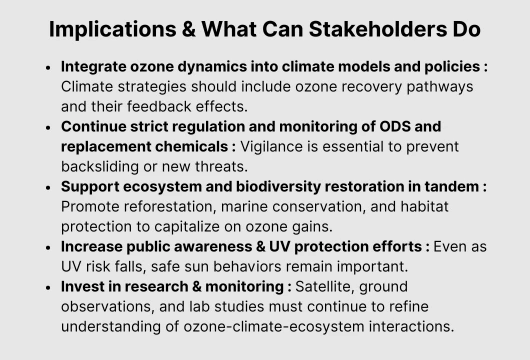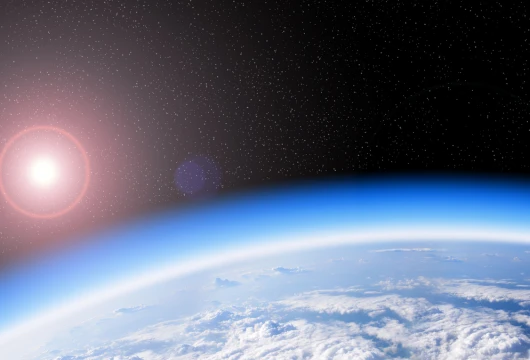How a Recovering Ozone Layer Delivers Health, Climate, and Ecosystem Gains
The ozone layer—our planet’s natural shield against the sun’s harmful UV radiation—is showing signs of recovery. After decades of damage caused by ozone-depleting substances (ODS) like chlorofluorocarbons (CFCs), global action (most notably the Montreal Protocol) has put the ozone layer on a path to healing.
This recovery is more than just a symbolic environmental victory. It brings with it tangible benefits across human health, climate dynamics, and ecological systems. In this article, we explore three major outcomes we can expect (and are already seeing) from the ozone layer’s gradual repair—backed by scientific findings and practical implications.
Outcome 1: Protection for Human Health & Reduced UV Damage

1.1 Less UV-B Exposure, Fewer Skin Cancers & Eye Disorders
One of the most direct benefits of a restored ozone layer is reduced ultraviolet-B (UV-B) radiation reaching the Earth’s surface. The ozone absorbs much of the UV-B spectrum (wavelengths 280–320 nm), which is particularly harmful to DNA in skin cells.
With more ozone present, a smaller fraction of UV-B penetrates, lowering risks of:
Skin cancers, including melanoma and non-melanoma types
Cataracts and other eye damage, due to UV exposure of the lens and cornea
Indeed, one estimate suggests that phasing out ozone-depleting substances will prevent hundreds of millions of skin cancer cases and tens of millions of cataracts over coming decades.
Indeed, one estimate suggests that phasing out ozone-depleting substances will prevent hundreds of millions of skin cancer cases and tens of millions of cataracts over coming decades.
1.2 Improved Immune Function & Lower Disease Burden
Excess UV radiation can suppress immune system function by affecting skin cells and immune-related processes. Healing of the ozone layer helps mitigate this immunosuppression effect, better protecting populations from infectious diseases and reducing vulnerability to UV-exacerbated health issues.
1.3 Broader Public Health Gains
By lowering UV-related disease incidence, countries can reduce healthcare burdens, increase quality of life, and shift resources toward other societal needs. In short, a healthier population supports stronger economic and social resilience.
Outcome 2: Climate & Atmospheric Benefits

2.1 Mitigation of Global Warming Through Reduced ODS Emissions
Many ozone-depleting substances, like CFCs and HCFCs, are also potent greenhouse gases. When countries phased them out via the Montreal Protocol, they not only prevented ozone damage—they also averted additional warming. The United Nations estimates that ozone recovery-related actions have helped avoid approximately 0.3 to 0.5 °C of global temperature rise by 2100 (on top of CO₂ mitigation efforts).
Thus, healing the ozone layer acts as a climate multiplier, complementing CO₂ and methane reduction efforts.
2.2 Stabilizing Stratospheric Temperature and Circulation
Ozone plays a critical role in the stratosphere’s thermal balance. It absorbs solar ultraviolet radiation, warming the stratosphere; changes in ozone levels affect atmospheric circulation patterns (jet streams, winds) which in turn influence seasonal weather, monsoons, and precipitation distribution.
As the ozone layer recovers:
- Stratospheric temperature gradients normalize, helping stabilize the jet streams
- This reduces extreme weather anomalies linked to disrupted atmospheric circulation
2.3 Enhanced Carbon Sequestration via Ecosystem Health
A healthier ozone layer eases UV stress on plants, leading to better photosynthesis and robust growth. That translates to stronger carbon sinks—forests, agricultural lands, and vegetation that pull down CO₂ more effectively. In essence, ecosystem recovery supports climate mitigation indirectly.
In fact, studies have shown that protecting the ozone layer also helps preserve plant capacity to absorb carbon.
However, it’s also worth noting a caution from recent research: some scientists warn that ozone recovery, by altering heat balance, could paradoxically add to warming in certain atmospheric layers—potentially increasing global warming by up to 40% more than predicted in some scenarios.
This counterintuitive effect requires careful modeling and integration of ozone dynamics into climate projections.
Outcome 3: Ecosystem Revival & Biodiversity Strengthening

3.1 Reduced UV Stress on Vegetation
High levels of UV-B radiation damage plant cells, interfere with photosynthesis, impair growth, reduce seed set, and weaken defense mechanisms against pests and diseases.
With the ozone layer healing, ecosystems receive gentler UV exposure, allowing:
- Healthier forests, crops, and wild flora
- Increased tree growth, leaf area, and carbon storage
Better resilience against drought, pests, and climate stressors
3.2 Revival of Aquatic Ecosystems & Marine Life
Much of ocean life—particularly phytoplankton, which form the base of marine food chains—is sensitive to UV-B changes. Higher UV levels reduce plankton productivity, affecting the entire marine food web.
With a recovering ozone:
- More stable UV conditions help phytoplankton rebound, restoring marine food chains
- Ocean ecosystems can better support biodiversity, fisheries, and carbon cycling
3.3 Ecosystem Services Preservation
When ecosystems recover, they renew the services that humans rely on—clean water, soil fertility, pollination, climate regulation, and more. A healed ozone layer thus strengthens the resilience of ecosystems to climate shocks, supports biodiversity corridors, and helps sustain ecological balance.
Synergies & Interdependencies
These outcomes—human health, climate stabilization, ecosystem revival—don’t exist in isolation. They reinforce each other in powerful ways:
- Healthier ecosystems boost carbon sequestration, feeding back into climate mitigation.
- Better climate stability protects agriculture and water systems, which in turn support food security and ecosystems.
- A healthier human population invests more in environment, research, and climate adaptation.
Thus, the ozone layer’s healing is a lever for cascading environmental and social benefits.
Current Evidence & ObservationsA recent study by MIT confirms that the Antarctic ozone has begun to heal, driven by reductions in ozone-depleting chemicals.
The World Meteorological Organization (WMO) reports that the ozone hole in 2024 was smaller than recent years, reinforcing the long-term trend of repair.
Scientists note that the ozone layer is expected to recover to 1980 baseline levels by ~2040 for much of the world, though polar regions may take longer (Antarctica by 2066).
UNEP emphasizes that ozone recovery has already helped avoid an estimated 0.5 °C of warming by reducing emissions of potent greenhouse gases tied to ODSs.
Challenges, Trade-offs & Caveats
While the healing of the ozone layer brings hopeful outcomes, it also introduces complexity:
- Warming feedbacks: As mentioned, some models suggest ozone recovery could intensify atmospheric warming in certain layers.
- Legacy ODS reservoirs: Many ozone-depleting chemicals remain in atmospheric reservoirs for decades; full repair is slow and dependent on consistent policy adherence.
- Emerging threats: New chemicals or activities (e.g., satellite re-entry emissions) could hinder future recovery.
- Interplay with climate change: Changes in temperature, atmospheric dynamics, and greenhouse gas concentrations may alter ozone recovery trajectories.
Thus, while healing is underway, it must be maintained with vigilance and integrated into wider climate strategies.

The healing of the ozone layer is a living testament to what coordinated global action can achieve. Its recovery yields three profound benefits: stronger human health, climate stabilization, and ecosystem revival.
While challenges remain—climate feedbacks, chemical risks, and the need for ongoing vigilance—this is a success story that should inspire further efforts in all domains of environmental protection.
The sky over us is slowly mending. May its healing echo across every life below.
For more inspiring Blogs, click here

